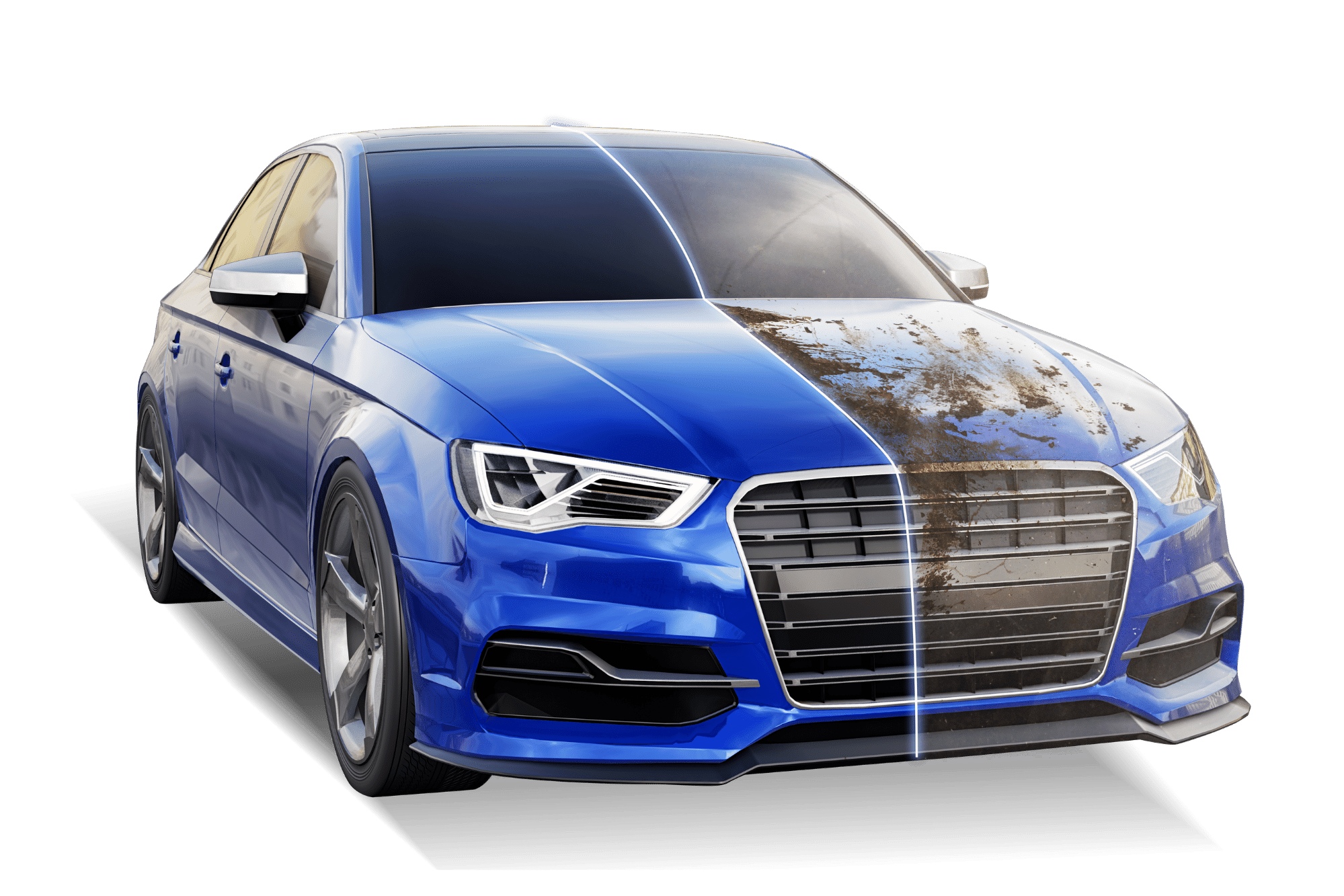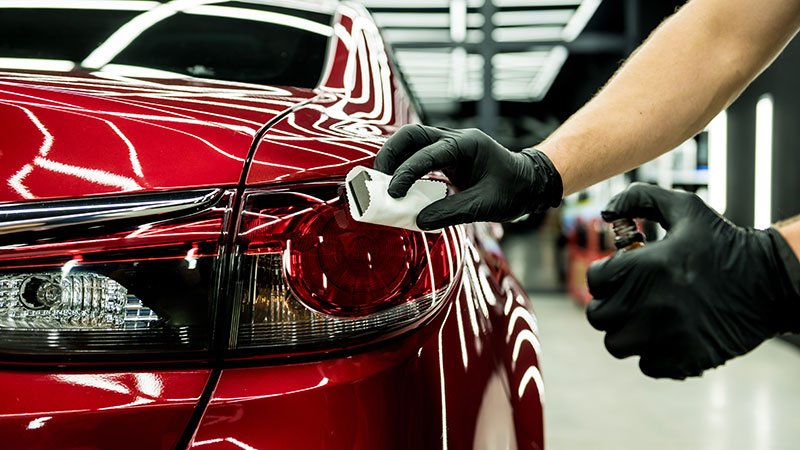Ceramic Coating Newark vs traditional wax — which is better
Wiki Article
Checking out the Science Behind Car Ceramic Coating and Its Protective Qualities
The scientific research of car ceramic coating offers a remarkable research in innovative vehicle defense. Made up primarily of silicon dioxide and polymers, these coverings develop a durable bond with lorry paint. This communication enhances longevity against ecological dangers while using hydrophobic benefits. However, the complexities of exactly how these coatings work and their lasting advantages stay less understood. Unloading these information exposes why ceramic finishings are coming to be a preferred selection for vehicle treatmentWhat Is Ceramic Coating?
Ceramic coating is a liquid polymer that chemically bonds to the surface area of a vehicle's paint. This advanced safety layer enhances durability and supplies exceptional resistance to ecological factors. Unlike typical wax or sealants, which supply short-term protection, ceramic coatings produce a lasting shield that can stand up to harsh problems such as UV rays, acidic pollutants, and severe weather. When used correctly, the coating develops a hydrophobic surface area, triggering water to bead and slide off, which assists in keeping the lorry's tidiness. Additionally, it uses boosted gloss and deepness to the paint, making the car show up more sleek and vibrant. The application process typically includes detailed surface area preparation, consisting of cleansing and polishing, to ensure peak bonding. Because of this, ceramic coatings are coming to be progressively popular among car fanatics and those looking for to safeguard their financial investments, guaranteeing to maintain the automobile's aesthetic appeal while lowering the frequency of upkeep.The Composition of Ceramic Coatings
The detailed formula of ceramic finishes mainly includes silicon dioxide (SiO2), which is originated from all-natural sources like quartz and sand. This vital component supplies the structure for the coating's toughness and protective high qualities. Along with SiO2, ceramic coatings frequently include various polymers and ingredients that boost adhesion, versatility, and resistance to ecological factors. These compounds work synergistically to produce a durable obstacle versus impurities such as dirt, chemicals, and UV rays.Furthermore, some formulations incorporate titanium dioxide (TiO2) or various other nanomaterials, which can enhance the coating's hydrophobic buildings, leading to improved water repellency. The specific structure can vary greatly amongst makers, influencing performance and durability. Inevitably, the combination of these components finishes in a protective layer that not just enhances the visual charm of lorries however likewise serves to prolong their life-span by securing the surface from possible damages.How Ceramic Coatings Job
Understanding how ceramic finishings function entails exploring their chemical composition, which contributes to their protective top qualities. The application procedure is essential for achieving optimal results, while durability and durability elements establish the coating's effectiveness over time. Together, these elements highlight the benefits and efficiency of ceramic finishings for vehicle security.Chemical Composition Explained
While numerous car owners look for durable security for their vehicles, the chemical composition of ceramic finishes plays a crucial duty in their efficiency. These finishes mostly include silicon dioxide (SiO2), which is originated from natural minerals. This compound creates a solid bond with the car's paint, producing a resilient, protective layer. In addition, lots of ceramic finishings include titanium dioxide (TiO2), boosting their hydrophobic properties and resistance to UV rays. The existence of polysiloxanes can additionally improve versatility and sturdiness. With each other, these elements add to the coating's capacity to ward off water, dirt, and impurities, while also giving a high-gloss coating. Comprehending this chemical structure helps car owners value the robust protection offered by ceramic coverings.Application Process Overview
Using ceramic layers entails a thorough procedure that guarantees optimal bonding and security for the automobile's surface. At first, complete cleansing and decontamination of the car's exterior are carried out to eliminate dust, crud, and previous waxes. This action confirms that the surface is devoid of pollutants that can prevent adhesion. Following this, the paint is usually polished to enhance quality and get rid of any flaws. When prepared, the ceramic coating is used in tiny areas making use of an applicator pad, enabling uniform insurance coverage. The coating is after that left to treat, forming a solid chemical bond with the surface. Appropriate healing times and problems are critical, as they confirm the coating achieves its maximum performance and protective qualities.Longevity and Durability Elements
Ceramic coatings are made to offer durable security through their innovative chemical structure, which produces a robust obstacle against environmental pollutants. The sturdiness of these finishes is influenced by aspects such as the density of the application, the top quality of the item, and the problems under which the automobile is exposed. Top quality ceramic finishings can last a number of years, resisting scratches, UV rays, and chemical stains. Correct upkeep, consisting of routine cleaning and regular reapplication, can additionally improve longevity. Additionally, ecological elements like climate and exposure to contaminants can influence the lifespan of the coating. In general, when applied and preserved correctly, ceramic coverings supply remarkable sturdiness, making them a preferred option for car fanatics looking for to protect their lorry's appearance.Hydrophobic Properties and Water Repellency
Hydrophobic residential or commercial properties are a characteristic of quality car ceramic finishes, considerably boosting the car's surface area efficiency. why not find out more These coverings develop a molecular bond with the car's paint, leading to a surface area that fends off water properly. When water enters into call with a ceramic-coated surface area, it beads up and rolls off, reducing the quantity of fluid that remains on the paint. This actions not just adds to a cosmetically pleasing look yet additionally decreases the accumulation of contaminants such as dust, gunk, and road salts.The boosted water repellency brings about much easier cleaning and maintenance, as much less effort is required to remove undesirable compounds. On top of that, the hydrophobic nature of ceramic coverings helps in preventing water spots, which can mar the coating of uncoated surfaces. Generally, the consolidation of hydrophobic properties in ceramic layers plays a necessary duty in maintaining the vehicle's excellent appearance while streamlining maintenance.Security Against Scratches and UV Damage
Car ceramic layers provide substantial security versus scratches and UV damages. The scrape resistance system develops a long lasting layer that takes in impacts, while the UV securing advantages help maintain the lorry's paint stability with time. With each other, these functions add to a longer-lasting and aesthetically attractive surface.Scratch Resistance System
Utilizing innovative technology, ceramic layers provide a durable shield against scratches and UV damages, boosting the longevity and look of car surfaces. The scrape resistance mechanism of these layers is credited to their distinct molecular framework, which forms a sturdy bond with the car's paint. This bond creates a hard, safety layer that can take in influences and withstand abrasions. In addition, the smooth surface of the coating decreases friction, making it difficult for impurities to adhere and trigger scratches. The chemical composition of ceramic coverings typically includes nanoparticles that enhance the safety layer, more improving its resilience. Consequently, lorries treated with ceramic layers show substantially improved scrape resistance compared to traditional wax or sealants, making certain an excellent finish in time.UV Shielding Conveniences
The protective qualities of ceramic coatings expand past scratch resistance to consist of considerable UV protecting benefits. These layers produce a robust obstacle that shows unsafe ultraviolet rays, guarding the automobile's paint and underlying materials. Extended exposure to UV radiation can result in fading, oxidation, and wear and tear of the paint finish. By incorporating ceramic coverings, car owners can effectively reduce these risks, maintaining the visual charm and integrity of their autos. In addition, the UV blocking homes contribute to enhanced long life, lowering the frequency of painting and maintenance. Ultimately, the integration of ceramic coatings provides a detailed service for shielding lorries from the damaging impacts of sun exposure, making certain a sustained, lively look over time.The Long life and Maintenance of Ceramic Coatings

Often Asked Concerns
Can Porcelain Coating Be Applied to Any Kind Of Type of Vehicle?
Ceramic coating can be related to different kinds of automobiles, consisting of cars and trucks, vehicles, and bikes. Nonetheless, surface area preparation and compatibility with particular materials are essential for suitable adhesion and effectiveness of the coating.Just How Much Does Ceramic Coating Usually Cost?
Ceramic coating commonly sets you back between $500 and $2,000, depending on aspects such as car dimension, coating quality, and specialist application. The investment can offer lasting protection and boost the automobile's appearance in time.
Is Expert Application Required for Best Results?
The need of specialist application usually relies on preferred results. Professionals usually ensure proper surface area prep work and application methods, resulting in optimal bonding and longevity of the coating, which look at more info might be testing for unskilled individuals to accomplish.Can Ceramic Coatings Be Eliminated or Fixed?
Ceramic finishings can be eliminated or repaired, though the process may call for details solvents or methods - Ceramic Coating Newark. Appropriate removal is vital this page to stay clear of damages to the underlying surface area, stressing the importance of specialist help for optimal resultsExactly How Does Ceramic Coating Compare to Traditional Wax?
The contrast between ceramic coating and standard wax reveals that ceramic layers use exceptional longevity, improved security versus ecological pollutants, and longer-lasting sparkle, while wax calls for extra regular application and offers much less general resistance to damages.Report this wiki page